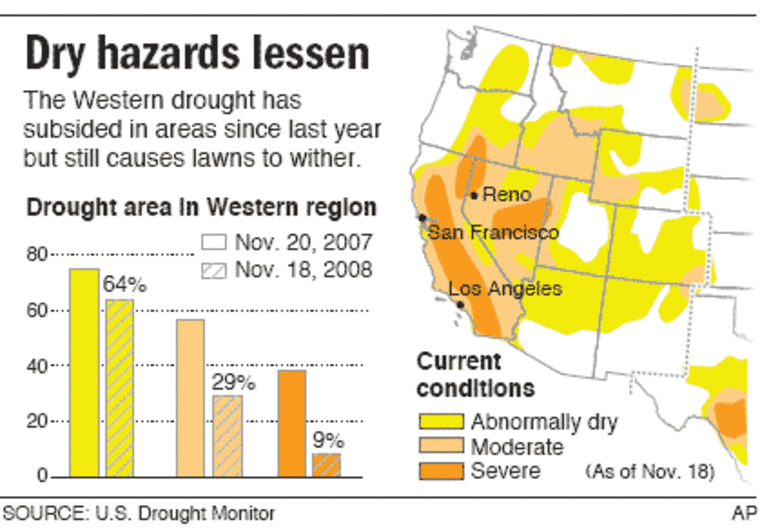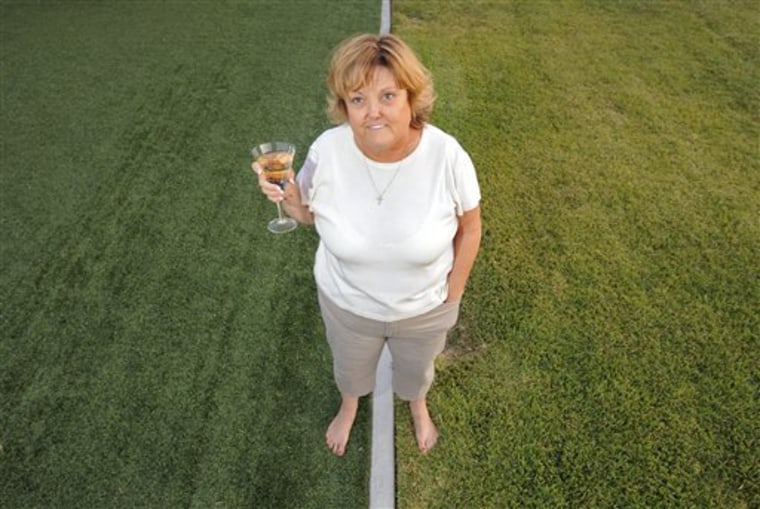Cookie Smith was surprised to learn the fake lawn that earned her a home-beautification award violated a city ban on artificial grass.
Her neighbor was shocked when he complied with a state order to conserve water and was instead threatened with a $50 fine for letting his grass wither to a brittle brown.
Such is the dilemma confronting Californians: Water supplies are dwindling, but some cities still require homeowners to maintain lush, green lawns. Other communities forbid artificial turf.
"It's kind of like saying 'We want you to look like Brooke Shields, but we don't want you to use any makeup,'" Smith said.
Now some cities are reconsidering their lawn laws and exploring alternatives to homes with perfect rectangles of green.
The state's ever-growing population and the threat of a prolonged drought could kill the concept of the traditional lawn in California, where some communities conduct patrols looking for signs that homeowners are lavishing too much water on their lawns or letting it dribble down driveways.
Officials estimate that up to 70 percent of a family's water bill is spent on landscaping.
End of an affair?
"Our love affair with the lawn may be coming to an end because if we're going to support all these people living here and all the homes, we're really going to have to use have water-wise designs," said Stephanie Landregan, who heads the landscape architecture program at the University of California at Los Angeles extension. "It's probably closer to our future than most people realize."
Still, many will be reluctant to abandon lawns entirely. Thick carpets of grass have defined the landscape of suburban America for more than a century, and a healthy lawn in this semiarid climate is a status symbol.

Some cities are weighing whether to lift bans on artificial turf that date back to the days when phony grass looked like fluorescent plastic. A few communities are also encouraging the use of native plants once derided as shaggy weeds.
Advocates of natural alternatives are not sold on fake grass, saying it's a petroleum product that can heat up too much in the region's searing summer weather and can harbor germs.
"This is just like putting a carpet outside," said Betsey Landis with the California Native Plant Society in Los Angeles.
Some water districts are offering customers $1 rebates for each square foot of lawn they remove and 30 cents per square foot of fake grass they install.
In the 1990s, residents in Santa Barbara made headlines during a drought by spray painting their grass green because it was illegal to water it. Now they can just roll out a carefree artificial lawn.
"Here's the paradox, people especially in Southern California want their lawns to look artificial in the front," said Jeffrey Barber of Pacific Sod in Camarillo. "They want it to look perfectly green and don't ever want it to yellow."
Bans being reviewed
In Orange County, six cities including Garden Grove are reviewing artificial grass bans. The once-stubby turf has come a long way since its most public debut at the Houston Astrodome in the 1960s. Now it looks and feels more like the real thing.
Smith, who paid about $10,000 for her patch of fake lawn, joined with other homeowners to ask that the bans be overturned after their requests for fake-grass rebates were rejected.
Though the turf is pricey, homeowners who have it save money on water. An estimated 750 square feet of fake grass can conserve about 22,000 gallons of water per year. Smith, whose $50-a-month water bill is dwarfed by those of her neighbors, called the ban "stupid."
"Not only do you not get a rebate, you're in violation of a city law. And if you don't remove it, the city will have to enforce the ordinance," Smith said.
In addition to ripping out the fake grass, violators can also be required to plant a real lawn and could be fined if they refuse. But since the city is reconsidering the law, it has suspended enforcement.
The Garden Grove City Council has met several times to discuss the issue but has yet to lift the ban. Elected officials have raised concerns about lead content in some fake grasses and about whether the city's oxygen levels would drop if enough fake lawns were installed.
The debate over lawns also takes place in a part of the country where hot, dry weather often leads to wildfires.
Landregan, the landscape design program at UCLA, said most grass fires involve taller grasses. Lawns typically don't burn unless they are completely dead. She said artificial grass has good fire-retardant qualities.
How near is the end?
John Rossi, general manager at Western Municipal Water District, which services cities including Riverside, Corona and Temecula, agrees that the end is near for the traditional lawn.
His district recently adopted the slogan "redefining green" — meaning planting water-efficient gardens, not necessarily green ones. Rossi said he tried to sell the concept of "brown is beautiful" with little success.
When it comes to the disappearance of real lawns, Rossi said, "the only question is the time frame. When we talk about 8 million more people coming into California in the next 20 years and there's no new water supply, it's not a matter of if, but when."
